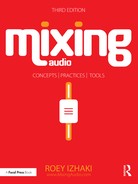Book Description
Mixing Audio: Concepts, Practices, and Tools, Third Edition is a vital read for anyone wanting to succeed in the field of mixing. This book covers the entire mixing process – from fundamental concepts to advanced techniques. Packed full of photos, graphs, diagrams, and audio samples, it teaches the importance of a mixing vision, how to craft and evaluate your mix, and then take it a step further. The book describes the theory, the tools used, and how these are put into practice while creating mixes.
The companion website, featuring over 2,000 audio samples as well as Pro Tools/ Multitrack Audio Sessions, is a perfect complement to the third edition.
The new edition includes:
- A new 'Mixing and The Brain' chapter that provides a cognitive/psychological overview of many aspects related to and affecting mixing engineers (and, to a narrow extent, listeners).
- Updated figures and text reflecting recent software updates and trends.
